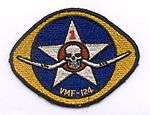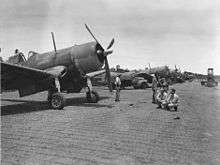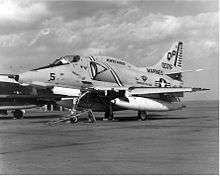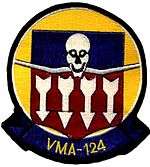VMA-124
| Marine Fighter Attack Squadron 124 | |
|---|---|
|
VMA-124 Insignia | |
| Active | 2 September 1942 - 1996 |
| Country | United States |
| Branch | USMC |
| Type | Fighter/Attack squadron |
| Role | Air interdiction |
| Nickname(s) |
Whistling Death Wild Aces Checkerboards |
| Tail Code | QP |
| Engagements |
World War II * Battle of Guadalcanal * Solomon Islands Campaign * Philippines Campaign, 1944-45 * Battle of Iwo Jima * Battle of Okinawa |
| Aircraft flown | |
| Attack | A-4 Skyhawk |
| Fighter |
F4U Corsair F9F Cougar FJ-4B Fury |
Marine Fighter Attack Squadron 124 (VMFA-124) was a flying squadron in the Marine Forces Reserve based out of Naval Air Station Memphis flying the A-4 Skyhawk. They were part of Marine Aircraft Group 42 and were decommissioned on 19 June 1999. The squadron is best known as the first Marine squadron to fly the F4U Corsair during World War II and also one of the first Marine squadrons to be based on an aircraft carrier. They were known as the “Wild Aces” and ended World War II with 78 air-to-air victories against Japanese aircraft.
History
World War II

VMF-124 was formed on 2 September 1942 at Camp Kearney, San Diego, California. They were declared fully operational on 28 December 1942 even though the squadron’s pilots had only an average of 25 hours each in the plane. They arrived on Guadalcanal on the morning of February 12, 1943 led by their commanding officer, Major William Gise. The squadron flew their first mission before lunch that day, with twelve F4Us escorting a PBY Catalina on a 230 mile mission to pick up two downed pilots at Sandfly Bay, Vella Lavella.[1]

The first F4U pilot to be decorated with the Medal of Honor came from VMF-124 — 1st Lt Kenneth A. Walsh for a mission on August 30, 1943, during which he shot down four Japanese Zeros before ditching his borrowed Corsair. The squadron remained in the Solomon Islands until September 1943, fighting over the Russell Islands, New Georgia and Vella Levella.
Following the fighting in the Solomons, the squadron was disbanded and reconstituted back in the United States where it trained in the Mojave Desert at Marine Corps Auxiliary Airfield Mojave for the next year.[2] When they received their orders for carrier assignments they had 5 combat experienced pilots as their training nucleus[3] VMF-124 left the States again on 18 September 1944, heading to Hawaii. While in Hawaii they were attached to Carrier Air Group 4 who were operating off the aircraft carrier USS Essex (CV-9). Along with VMF-213, 124 became the first Marine squadron to be based on a fleet aircraft carrier.[4] While deployed aboard the Essex, they took part in fighting over Lingayen, Luzon, Formosa, Tokyo, Iwo Jima and Okinawa. On 3 January 1945 VMF-124 and VMF-213 struck Formosa and the Ryukyu Islands in the first Marine land strike off a carrier.
Reserve activity
The squadron was reformed shortly after the war at Naval Air Station Memphis and were equipped with the F4U-4 Corsair. They were the first squadron in the newly formed Marine Air Reserve Training Command to reach full strength. The squadron was redesignated Marine Attack Squadron 124 (VMA-124) on May 1, 1965 and were subsequently equipped with the A-4 Skyhawk. During the 1970s and 1980s they flew various versions of the A-4 until 1994 when the squadron was moved to Naval Air Station Joint Reserve Base Fort Worth and redesignated Marine Fighter Attack Squadron 124 (VMFA-124). The squadron existed as a paper squadron only for two years while awaiting F/A-18 Hornets that would never materialize. The squadron existed on paper only until they were finally deactivated in 1999.[5]
Squadron aces

The following members of VMF-124 were credited with at least 5 enemy aircraft shot down during World War II:
- William E. Crowe
- Howard J. Finn
- Wallace E. Sigler
- Kenneth A. Walsh
See also
- United States Marine Corps Aviation
- List of active United States Marine Corps aircraft squadrons
- List of inactive United States Marine Corps aircraft squadrons
References
- Notes
- ↑ Tillman Corsair, p. 29.
- ↑ "The Mojave Virtual Museum - The "Mojave Marines": Life at MCAAS Mojave". Mojave Transportation Museum. Retrieved 2008-06-25.
- ↑ Condon Corsairs and Flattops, p. 11-12.
- ↑ Fredriksen, John C. (2011). The United States Marine Corps a Chronology, 1775 to the Present. Santa Barbara: ABC-CLIO. p. 175. ISBN 9781598845433.
- ↑ Ginter & Albright (2001), p. 8
- Bibliography
- Condon, John Pomeroy (1998). Corsairs and Flattops - Marine Carrier Warfare, 1944-1945. Naval Institute Press. ISBN 1-55750-127-0.
- Ginter, Steve; Albright, Steven (2001). Douglas A-4E/F Skyhawk in Marine Service. ISBN 0-942612-52-3.
- Tillman, Barrett (1979). Corsair - The F4U in World War II and Korea. Naval Institute Press. ISBN 1-55750-994-8.
- Web
- Mersky, Peter B. (1993). "Time of the Aces: Marine Pilots in the Solomons, 1942-1944". Marines in World War II Commemorative Series. History and Museums Division, Headquarters, U.S. Marine Corps. Retrieved November 3, 2007.
- Sherrod, Robert. "USMC Fighting Squadrons". Cactus Squadrons: Guadalcanal, Aug. 1942 - February 1943. Retrieved 2006-07-15.
- Marine Fighting VMF-124 and VMF-213 - History and photos of VMF-124 and VMF-213's service aboard the USS Essex (CV-9)

